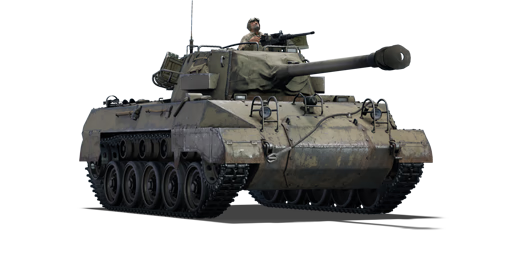



In response to the threat of German armoured units that contributed to the Fall of France, the United States developed the Tank Destroyer Branch whose purpose was to help squash armoured breakthroughs from expanding past the front lines. As part of their role, the branch required combat vehicles that were well-armed and were mobile enough to respond to any strategic events. Making do with interim vehicles like the M3 GMC and M10 GMC, the ideal project to develop a vehicle for this role was the T70 by Buick, a fast tank destroyer armed with a 76 mm gun. The vehicle was approved and put in production in Summer 1943 as the M18 GMC and was also associated by its manufacturer's nickname "Hellcat". Though not as numerous as its interim counterparts, the M18 became one of the primary arms of the tank destroyer branch, with its firepower and mobility coming to play in several key battles in the European Theater such as the Battle of the Bulge.
Introduced in Update 1.49 "Weapons of Victory", the M18 "Hellcat" was the epitome of the American tank destroyer doctrine. It is very fast, very mobile, and has a powerful gun, though with a large trade-off of only 12.7 mm (0.5 inches) of armour. Unlike many other tank destroyers in the game, the M18 "Hellcat" has access to a 360° traversable turret, allowing players to have a greater arc of fire than a typical casemate tank destroyer like the StuG III, but at the expense of a slightly higher profile. American tank destroyers also have very high manoeuvrability compared to those of other nations, allowing it to flank the enemy. The main weak point of the M18 is its very thin armour, a feature that actually allows the M18 to reach its high speed. The thin armour makes it possible for any enemy tanks to penetrate the vehicle, a single hit destroying many critical components in the M18 or crippling the crew. The only saving grace with this extremely thin armour is that standard AP rounds may over-penetrate the armour, doing minimal damage to the internals.
Although it is most recognized for its role as a tank destroyer, it was recategorized as a light tank during Update "Ixwa Strike" on 7 May 2021.
| Ammunition | Type | Armor penetration (mm) at a distance: | |||||
|---|---|---|---|---|---|---|---|
| 10 m | 100 m | 500 m | 1000 m | 1500 m | 2000 m | ||
| AP | 134 | 132 | 121 | 109 | 99 | 89 | |
| HE | 16 | 16 | 14 | 13 | 11 | 10 | |
| APCBC | 149 | 146 | 133 | 119 | 106 | 95 | |
| APCR | 190 | 186 | 167 | 146 | 128 | 112 | |
| Smoke | 3 | 3 | 3 | 3 | 3 | 3 | |
| Belt | Belt filling | Armor penetration (mm) at a distance: | |||||
|---|---|---|---|---|---|---|---|
| 10 m | 100 m | 500 m | 1000 m | 1500 m | 2000 m | ||
| API-T/I/AP/API-T | 31 | 29 | 21 | 14 | 9 | 6 | |












Mobility | |
|---|---|
Protection |
|---|
Firepower | ||
|---|---|---|